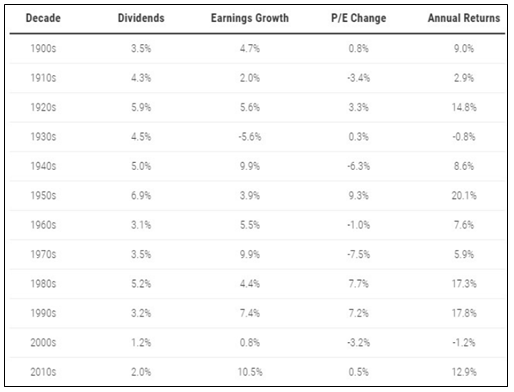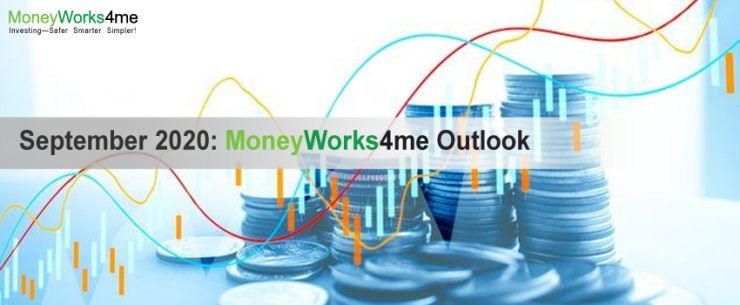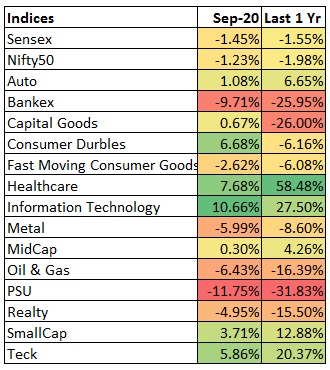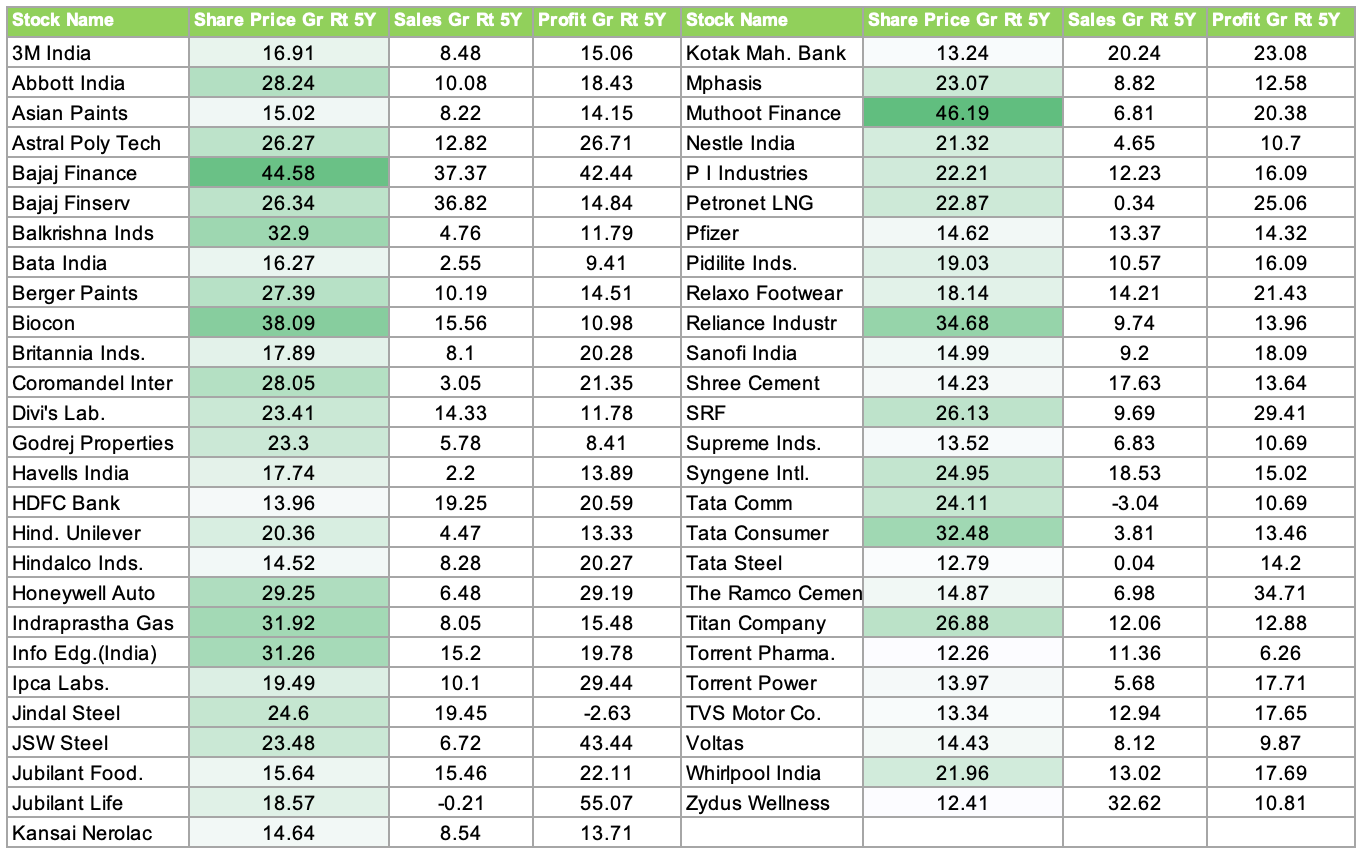This article covers the following:
Review
As on Sept 31 2020, Nifty closed at 11247.55, around -2% lower over last year. In the last 3 years, Nifty is up 14% translating into ~4.7% CAGR.
Nifty has bounced back 49% from its intraday lows with healthy participation across the board. The announcement of Fiscal stimulus by the US government and quantitative easing from the central bank across the world may have caused a break on selling pressure inequities. Off late, the increased activity of retail investors in mid and small cap space also led to a recovery in small and mid-cap indices as well.
We had turned cautious on market on Sept 22nd 2020 and informed our subscribers about market correction ahead as we saw stocks other than the top 10-15 stocks correcting on high volumes. Currently, the rally in Nifty, led by Banks and IT, doesn’t reflect weakness in the market.
FII sold Rs. 7,783 Cr worth of shares in Sept’20 versus purchases of Rs. 47,000 Cr in Aug’20.
As per our previous note, GDP may have contracted in the 20-25% range, the actual print came out a decline of 23.9% year on year. US GDP contracted by 9% and 33% annualized in the Apr-Jun’20 quarter.
Outlook
As of date, the average upside of our coverage universe is likely to be more than 11% CAGR over the next 3 years based on current estimates.
We find that the Nifty 50 index trades above its fair value while there are pockets of extreme overvaluation and undervaluation. A lot of liquidity helped beaten-down stocks to rally however, the economic indicators do not point to a V-shaped recovery as yet.
Small-cap and companies with earning disruption from a lockdown are very likely to come off during market reversal.
Companies in sectors like chemicals, pharmaceuticals, IT, Telecom, utilities, and rural-focused companies will report good earnings this year. These sectors will recover first once the market correction is over. Most of the stocks in these sectors are trading below to fair price or slightly above fair value.
We are looking at companies that have good earning triggers over the next 2 years as we are not certain whether broad-based recovery will happen immediately.
We are investing in companies;
- Coming out of sector consolidation/debt reduction, or
- Introducing new products, or
- Commissioning new capacities, or
- Executing orders in hand.
This gives certainty of growth rather than plain anticipation.
We would avoid bargain hunting in sectors or stocks that may have become cheap but they have high debt or they operate in cyclical sectors. There is a good reason to believe that until demand recovers, the discretionary (usually cyclical) won’t come back. Hence we are avoiding directly hit sectors like Hotels, Transport, Multiplexes, and discretionary consumption sectors like Autos, large ticket consumer durables, etc.
We have not aggressively added new ideas due to uncertainty about how the businesses shape up in the next few quarters so also as the market is back in correction mode due to liquidity drying up from initial global stimulus and US election.
We are looking for more opportunities in exports like Chemicals, Pharma, Textile, or Light Engineering with more opportunities opening up for Indian companies as well as better recovery in the developed world versus India. Even if the recent returns look high, they have a long runway from increasing market share globally. We will cautiously pick stocks that show actual data proving our hypothesis rather than buying any stock as a theme.
Risks
Indian Economy
GDP data saw the biggest decline versus other countries due to more stringent lockdown as India’s large population made it necessary to contain the virus quickly. Unfortunately, the cases are still on the rise as more people returned to work and started traveling.
Many sectors are coming out of hibernation of Lockdown from low 10-20% utilization to around 60-70% utilization in August’20. Popular high-frequency data like car registration, toll roads, diesel usage, and electricity generation show month on month improvement but still lower than pre-COVID levels.
We are tracking i) GST collections per month (starting August) ii) Auto Sales (Retail recovered to Feb level but pent up demand not exciting) iii) Cement offtake (Still low). Other indicators may or may not indicate actual recovery as they might be too concentrated on one segment or they might be lagging indicators.
While every sector operates in the same economy, the effects of Covid-19 would affect them differently. The experts are using the term ‘K’ shaped recovery for the same. On the right side upward curve shows few sectors benefitting immensely while the lower curve showing other sectors falling further.
Examples include (beneficiary vs loser) OTT versus cinemas, private transport versus public, organized versus unorganized, telecom versus electricity, consumer foods versus consumer discretionary, fast-food chain versus hawkers, edtech versus schools.
Beyond a point forecasting, macroeconomics is tough. We remain optimistic that the pandemic will affect only near term economic parameters but it won’t dampen the demographics of the country nor can it stop the long term momentum in GDP growth and rising consumerism.
US markets are performing better and their economy is recovering faster; Is it a good time to buy US equity?
US markets have delivered fabulous returns in the last decade versus emerging markets including India. From 2010 to 2019, US delivered close to 13% CAGR stock returns, and even higher 16.5% in INR terms.

If you observe, US has had stellar earnings growth in the last decade (2010-2019) versus any of the decades in the past century. Few reasons for such a run were:
- Low base i.e. 0.8% CAGR from 2000-2009
- Increase in share of higher growth and ROCE companies in Index
- Lower interest rates helping the company raise debt to announce buyback.
Every economy goes through a cycle. Upcycle is followed by a downcycle and vice versa.
India: Nifty had 13% CAGR earning growth from 1998 to 2009. This lead to a stock market rally of 14% CAGR during the same period. While in 10 years 2009-2019, earning growth of Nifty has been ~7% CAGR, leading to a 6% CAGR appreciation in Nifty.
Why should we avoid taking fresh Exposure to US?
While one can’t predict exactly what the next decade holds for an economy, but broadly, one has to make sure not to get caught near the peak of any cycle.
High Base: Whether US economic cycle is at a peak is debatable, but the risks are certainly too high for US economy to disappoint from current levels as its earnings at a high base.
At the start of the decade, the corporate profits were in lower range while currently, they are in a higher range if not peak, since 1947. From here the room for expansion is limit assuming peak profits as % of GDP won’t exceed the previous high of 2012.
Interest rate cycle: It is argued that long-term interest rates decide equity valuation, the current high valuation is justified due to lower interest rates.
Interest rates are at the lowest level with little room on the downside based on the conventional interest rate regime. (Negative interest rate could be an unconventional way to boost the economy but no evidence whether it succeeds). If the interest rates don’t fall further, the valuation might be capped at some level eventually, what if at the current level?
P.S. Lower interest rate is bullish for Gold
US Government Debt: US Government debt has been at the highest level since 1966 at ~140% and likely to increase more.
While the Central Banks believe that US Central Bank will help US never default by way of printing more money, but high debt levels certainly mean, i) increase in tax rate ii) subdued government expenditure in case of a slowdown.
Is it the right time to add a fresh sum in equity?
Fresh investment in equity must be linked to long term goals rather than market timing. If you have more than a 5-year investment horizon, it is always a good time to invest in equity. After committing long term savings, one has can go aggressive or defensive within an equity portfolio based on market valuation.
The best action is to focus on individual companies with good prospects and keep buying them on every small correction.
If we buy good quality companies with good growth, we will make a good return irrespective of the market. The above table shows that companies that reported good sales and profit growth CAGR over the last 5 years have earned more than 12-20% CAGR versus Nifty’s 7% CAGR. This gives us confidence that the market does reward individual companies even if the average market is lackluster over the next 12-18 months.
In every market cycle, the type of stocks that perform well keep changing. Consumer stocks and financials had a good run in the last decade, this may change in the future where pharma and engineering sectors can perform well as they have got a tailwind from global manufacturing looking for new avenues for sourcing.
For the mutual fund’s portion, one can go with SIP with a diversified process of investing. Quality and growth funds can lose in performance to value and growth at a reasonable price because of valuation differential.
Stocks have rallied, what if they correct after we buy them?
Currently, the market is seeing signs of correction due to US election, regional lockdown in Europe, liquidity drying up from initial global stimulus. While market correction is visible, one can’t predict the intensity or depth of correction; So we do not recommend more than a portion of the portfolio in cash. Volatility can’t be avoided but can be taken advantage of. A portion of cash set aside can be used to buy stocks in a correction.
We are managing only long term money and predicting near term events is futile. We do not find any merit in second-guessing what’s going to happen in the next 6 months-1 year. If the shortlisted stocks are good companies, with good growth prospects, they will bounce back as soon as the selling stops. This clearly shows picking the right stocks must be easier than predicting the market.
How to manage asset allocation: If you are afraid about the economy, people losing jobs, your own finances, commit lower than usual in equity. Say instead of Rs. 100 in equity in normal times, commit only 60 or 70 or even 50 is fine. But after doing this, do not wait for bottom prices or get scared of volatility because there is always a risk of missing out on 13-15% CAGR returns right on our platter. Keep buying with this amount and wait for your comfort to add more. This is better than regretting missing out on the entire amount.
We continue to recommend Gold Fund/Gold (up to 5-10% of the portfolio) as a hedge from contagion risks and allocation to safe liquid funds/Fixed Deposits (10-20%) within in equity portfolio for capturing new opportunities.
How to allocation funds: Restrict your allocation to 3-5-7% in each stock and diversify across 20-25 names. And not more than 25% in each mutual fund. This will keep you at peace, and not significantly dent your portfolio performance.
Avoid any type of regret while investing. Regret can come either missing stock or not adding enough to a winning stock. Rather focus on overall strategy as explained above.
Beyond this, tinkering with asset allocation will only reduce long-term returns thereby missing one’s target corpus. We have diversified our stocks portfolio, we have diversified assets and we have a long term horizon. Together this takes care of all potential risks in investing.
MoneyWorks4me Outlook:
If you liked what you read and would like to put it into practice Create Free Account at MoneyWorks4me.com. You will get amazing FREE features that will enable you to invest in Stocks and Mutual Funds the right way.
Need help on Investing? And more….Puchho Befikar
Kyunki yeh paise ka mamala hai
Start Chat | Request a Callback | Call 020 6725 8333 | WhatsApp 8055769463

















